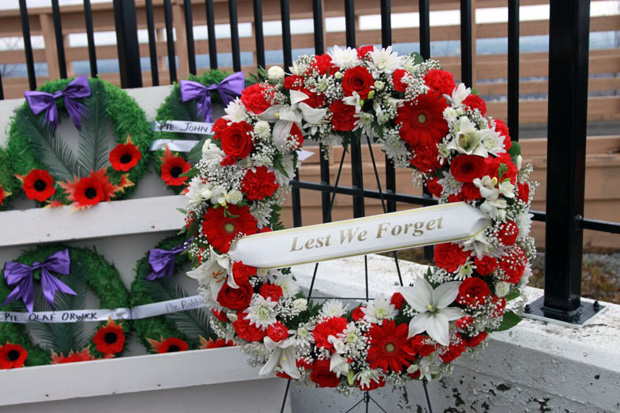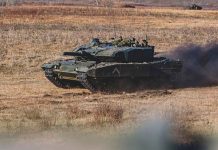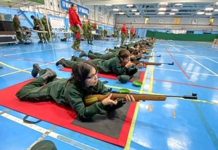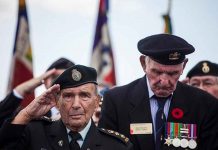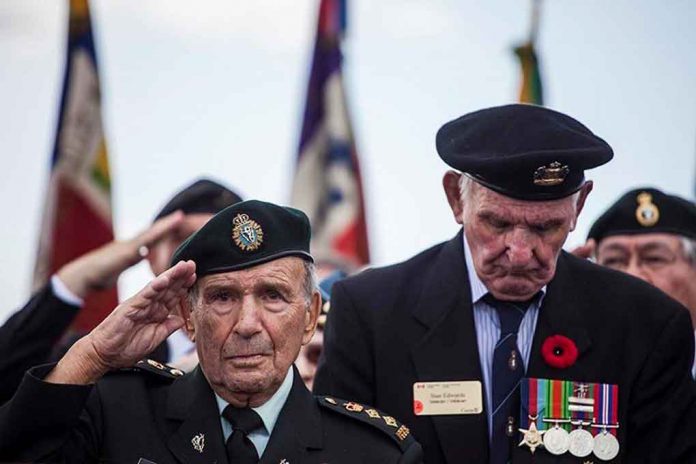
OTTAWA – Canada’s oldest and longest-serving officer passed away on Wednesday, March 27, 2019 at the age of 101. Decorated Dieppe Veteran, Honorary Colonel David Lloyd Hart, MM, CD led an extraordinary life in service to Canada.
As a Communications Operator during the Second World War, then-Sergeant Hart was awarded the British Military Medal (MM) for bravery by His Majesty, King George VI, at Buckingham Palace. The actions for which the MM was awarded took place on the battlefield during the Dieppe Raid in 1942, a day which remains as the bloodiest single day of combat for Canada’s military in the entire Second World War.
After the war, Honorary Colonel Hart joined the Army Signal Reserve, eventually being promoted to the rank of Lieutenant-Colonel in 1961 to command 11th Signal Regiment.
He retired from active service in 1965 but served continuously in honorary positions until his death.
“When looking at the life of this Canadian military icon, we are truly thankful for his dedication, courage and contribution to the military and Canadians. Not only was he decorated for saving lives during World War II but he spent his entire adult life serving Canada and inspiring fellow soldiers both on active duty and in honorary positions. The Canadian Army would like to extend its deepest sympathies to Honorary Colonel Hart’s family and Regiment,” stated Lieutenant-General Jean-Marc Lanthier, Commander Canadian Army.
“I am very saddened by the passing of Honorary Colonel Hart, who was an inspiration to many generations. He was an example to all and made a very significant contribution in the strengthening of the Reserve units within the 2nd Canadian Division. A friend and mentor to many, from soldiers to commanders, his absence will be heartfelt. I wish to pay tribute to this extraordinary man and express my deepest condolences to family, friends and the military community,” said Brigadier-General Jennie Carignan, Commander 2nd Canadian Division and Joint Task Force (East).
In 2013, Honorary Colonel Hart was one of the first recipients of the Communications and Electronics Colonel-in-Chief’s Commendation. The commendation was presented by Anne, The Princess Royal, for a lifetime of outstanding service to the Communications and Electronics Branch of which she is the Colonel-in-Chief.
The Dieppe Raid
Operation Jubilee, more commonly referred to as the Dieppe Raid, was an Allied assault on the German-occupied port of Dieppe, France on 19 August 1942, during the Second World War. The main assault lasted less than six hours until strong German defences and mounting Allied losses forced its commanders to call a retreat.
Over 6,000 infantrymen, predominantly Canadian, were supported by The Calgary Regiment of the 1st Canadian Tank Brigade and a strong force of Royal Navy and smaller Royal Air Force landing contingents. It involved 5,000 Canadians, 1,000 British troops, and 50 United States Army Rangers.
Objectives included seizing and holding a major port for a short period, both to prove that it was possible and to gather intelligence. Upon retreat, the Allies also wanted to destroy coastal defences, port structures and all strategic buildings. The raid had the added objectives of boosting morale and demonstrating the firm commitment of the United Kingdom to open a western front in Europe.
Virtually none of these objectives were met. Allied fire support was grossly inadequate and the raiding force was largely trapped on the beach by obstacles and German fire. Less than 10 hours after the first landings, the last Allied troops had all been either killed, evacuated, or left behind to be captured by the Germans. (Source: Wikipedia)
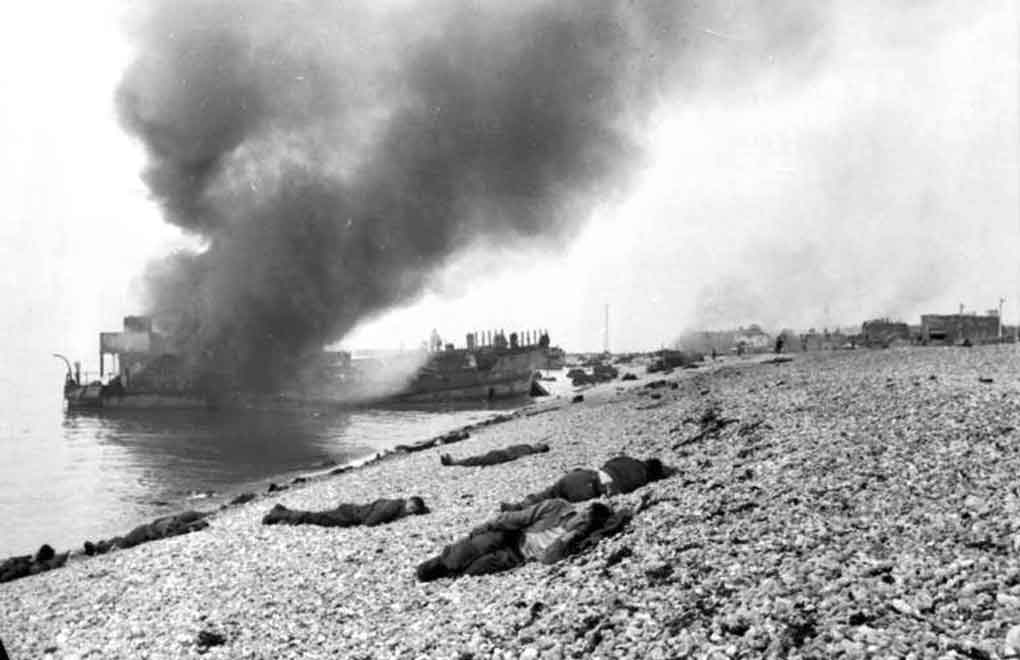
More details
Destroyed landing craft on fire with Canadian dead on the beach. A concrete gun emplacement on the right covers the whole beach. The steep gradient can clearly be judged.
Dieppe hero recounts his role on that fateful day
People were being shot at; people were being killed all over. It was an absolute catastrophe and I could see and hear the disaster taking place all around me. We were left immobilized near the beach and I thought I was going to be taken prisoner.
This chaotic and devastating scene is how Honorary Colonel David Lloyd Hart, now 96 years old, describes the fateful 1942 Allied attack on the German-occupied town of Dieppe in Northern France known as “Operation Jubilee.”
The Dieppe Raid was one of the most devastating and bloody chapters in Canadian military history. Approximately 5000 Canadians made up the bulk of the 6100-strong Allied force. Supported by eight destroyers and 74 air squadrons, they battled 6000 well fortified and entrenched German soldiers. The casualties for Canada totalled 3367, including 913 dead and 1874 prisoners of war.
We knew there was going to be a raid. Of course, the training was pretty rigid. But the intelligence was bad. We thought there was only going to be 1000 German troops and we had 6000. But Dieppe had been reinforced by 5000 seasoned German soldiers. It was a 1-1 ratio. And you don’t normally do a full frontal assault unless you have at least 3-1 superiority.
HCol Hart, a Sergeant in the Canadian Army at the time, was the only communication link between the frontline and the headquarters. In the confusion of the raid, communication was essential to the survival of the Allied troops.
HCol Hart spent much of the battle communicating with the frontline, reporting back to headquarters and relaying movement, reinforcement and retreat orders to the troops.
In the heat of battle he radioed to forward units that rescue craft would be arriving at 10:00 a.m. instead of 11:00 a.m., a crucial change in operational plans. And, at one point during the battle, he cut off communication with headquarters in order to relay retreat orders to the Camerons and the South Saskatchewan Regiment, who were under heavy fire and could not be reached by headquarters.
I knew I had a frequency I could contact them with if I could get off the air. Discipline was very rigid those days as far as using radio. I had to ask for permission to get off the air and was told no because I was the only communications forward and back. I promised to come back in two minutes and they agreed. I got off the air, got a hold of the two units, gave them the order to come out and was back on the air in 30 seconds.
This scene is depicted in a painting by Montreal artist Adam Sherriff Scott who died in 1980. HCol Hart sat with Scott for six days describing what happened.
The painting shows the aircraft overhead, the seawall where the men and tanks were pinned down under fire and engineers on the landing craft shooting at enemy aircraft. HCol Hart is depicted in the bottom right with a communications device in hand.
The picture is currently hanging at 4625 Catherine Street West in the 34 Signal Regiment, Royal Montreal Regiment building.
HCol Hart saved countless lives, was given a commission and was awarded the Military Medal for bravery and to “coolness under fire in the continuous performance of his duties.” The citation came out three months after the Dieppe Raid and HCol Hart received his medal from King George VI himself in Buckingham Palace.
He went on to study accounting but stayed in the military, eventually rising to the rank of Lieutenant-Colonel in 1965 before being honourably discharged.
He was an Honorary Lieutenant-Colonel from 1976 until April 23, 2013 when he was promoted to full Honorary Colonel of 34 Signal Regiment. At 96 he is semi-retired and still occasionally practices accounting.
For his part in the war he says: “I had been a high school cadet from ’31-’34, liked the Army and could see the winds of war were starting in ’37. So I joined. Thought maybe I’d be able to do my bit. And I guess I did.”
Article by Ryan Ferrara, Army Public Affairs


